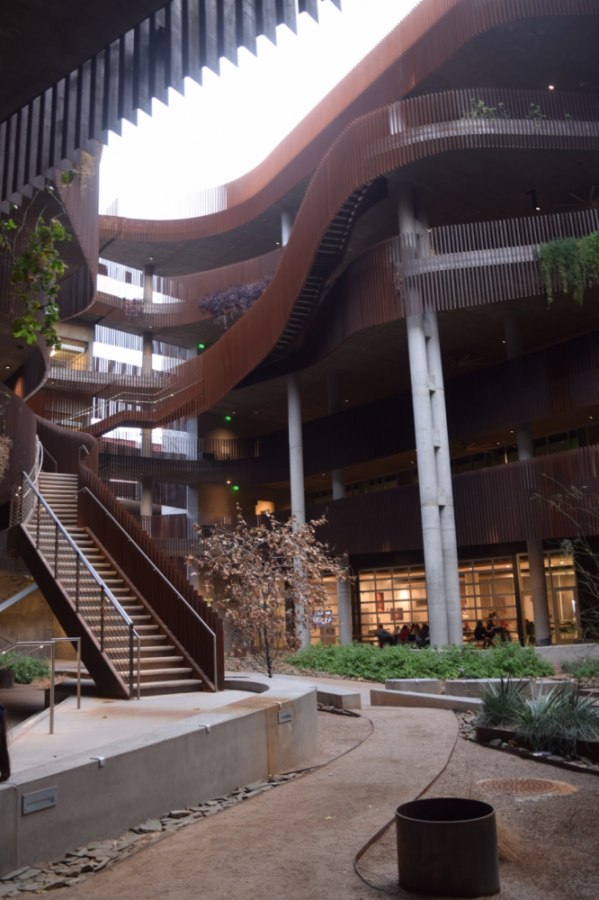Sandwiched between Sixth Street and Lowell Street, the Environment and Natural Resources Building 2, or ENR2, is located at the south end of campus and provides several floors of offices and laboratories for, notably, the UA Department of Mathematics, School of Geography and Development, School of Natural Resources and the Environment and the university’s sustainable research initiative, the Institute for Energy Solutions. As with seemingly every building on campus, the first floor will likely only be of relevance for most undergraduates; the floor houses N120, a 600 person, high-tech auditorium; Slot Canyon Cafe and some often quiet restrooms.
Construction began in 2013 and was designed to imitate the slot canyons of the Southwest, a natural phenomenon that can be described as narrow crevices or gorges found elsewhere. The purpose for this construction was retrieved from the UA’s Institute of the Environment website as the, “ … University of Arizona’s commitment to environmental sustainability … research … and studies that focus on earth science, environmental programs and natural resources.”.
RELATED: OPINION: The truth, ideally, would be free. It’s not
Two years and $75,000,000 later, the University unveiled ENR2, a supposed innovative piece whose main attraction was its fascinating courtyard, with overtones of the most contemporary sustainable designs. The Urban Land Institute, a non-profit that advocates for efficient urban development, noted the ENR2 helps, “ … the university’s and departments’ images, [which is] a benefit in recruiting staff members and students.”
Indeed, finally, both current and prospective students and faculty were able to indulge in the five floors of balconies, railed with metals that invoke the ephemeral thought: “Is this a junkyard?” Currently, we witness the surroundings of bare concrete in harmony with natural vegetation. We’re sold a building they say is so magnificently designed that it is truly the epitome of progressive architecture; LEED certified, self temperature regulating, low energy, beautiful, the future.
RELATED: OPINION: Get Vaccinated
Art and beauty are said to be subjective, so it’s tiresome and cheap to debate over ENR2’s purely aesthetic qualities. Objectively, the design of ENR2 is a relic of another time, arguably an appropriation of already existing architecture from halfway across the world. On April 26 1986, a reactor meltdown occurred in the former Ukrainian Soviet Socialist Republic at the Chernobyl Nuclear Plant in the town of Chernobyl and nearby Pripyat. The meltdown was not contained and triggered an explosion that spread substantial radioactive material across the northern region of Ukraine and nearby Belarus. Thousands of Chernobyl and Pripyat residents were forced to evacuate, leaving the bare-concrete buildings that remain there today.
After several decades of human absence, the Stalinist architectural school became one that was coherent with Western environmentalist vision and, evidently, UA faculty. Indeed, finally had they seen beauty in architecture so simplistic, so two-dimensional, so incredibly boring, that the rest of us are left incredulous to see such nonsense undertaken beyond the drawings of youth pasted to the doors of a refrigerator. But wait! Photos of Chernobyl reveal buildings in harmony with the natural environment, free from such shackles of human oppression like landscaping, utility, enclosure and reflective of regional culture. This sounds familiar.
ENR2, plants rampant and widespread? Check. An abstract, amateurish, esoteric art project in the middle of the “Old Pueblo”? Check. Looks like the aftermath of Soviet radiological disaster? Check.
While it is sloppy to conclude ENR2 is a copy-paste transplant done for a whopping $75,000,000, the lengths other institutions, governments and celebrities go to just to fill the checkbox “Without a doubt most certainly; unequivocally; clearly committed to environmental sustainability” frankly leaves that sloppy conclusion as the only legitimate conclusion. What if it’s not? Well, there are some of us that take great emotional distress over bad, incoherent architecture on campus, and we deserve representation. #ReturnENR2ToChernobyl
Follow the Daily Wildcat on Twitter









